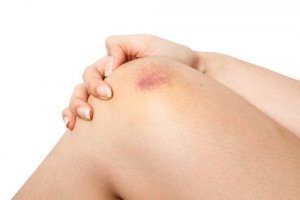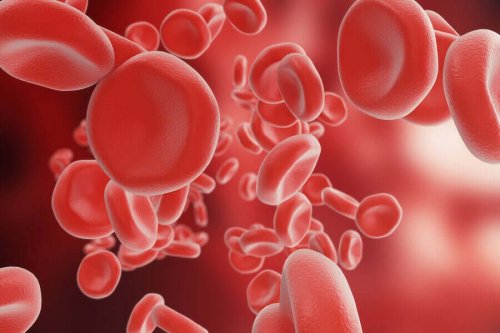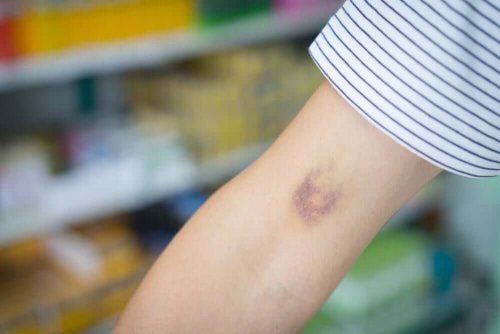Ecchymosis - What Is It Exactly?


Written and verified by the doctor Leonardo Biolatto
An ecchymosis is one of the basic types of skin lesions. It’s the basis of the many other types of illnesses and conditions, along with other dermatological symptoms.
You could say that ecchymosis is a subcutaneous blood deposit. This is because there are no wounds or accompanying lesions on the skin above it. So, this accumulated blood is the result of ruptured blood vessels.
When blood goes out of the blood vessels it’s called extravasation. The ecchymosis comes from extravasation below intact skin. That is, there are broken, open blood vessels either caused by a blow, an infection that destroys them from within, or due to torn muscles in that area.
Ecchymosis is a dermatological lesion but it doesn’t only affect the outer skin. This type of lesion can also develop under a mucous membrane – in the internal region of the oral cavity, for example.
Causes of ecchymosis
There are several things that can cause ecchymosis. The rupture of the vessels and the extravasation of blood into the subcutaneous space is the end result. However, the causes may be:
- A trauma, such as a blow to the skin that doesn’t rupture it. That is, something caused by a non-sharp object. Keep in mind that ecchymosis only happens when there are no superficial skin wounds.
- Ecchymosis is common among athletes. Sometimes it’s due to trauma and other times by the kind of overexertion in training that can injure the muscles.
- Vitamin K is an essential substance for proper blood clotting. A deficiency of this vitamin in the body is the perfect setting for ecchymoses to form.
- Certain infectious processes can weaken the blood vessels and break them from the inside, without rupturing the skin. Sometimes ecchymoses are the first symptom of an infection. They can appear even before the onset of fever.
- As with vitamin K deficiency, a person with a coagulation disease such as von Willebrand is more prone to develop an ecchymosis. In addition, a coagulation disorder can also be a secondary symptom of another condition such as cancer.
- There are diseases that a person must take anticoagulants for. Their use has the adverse effect of forming spontaneous ecchymosis or small trauma, which, under normal conditions, wouldn’t rupture the blood vessels.

Read also: Treatment of Soft Tissue Injuries
How it forms
Ecchymosis, as defined above, is an accumulation of blood in the subcutaneous space under intact skin. The process is self-limited and, after a certain period, the blood reabsorbs itself into the body.
During re-absorption, which may take weeks, the skin color of the affected area changes. The color changes reveal the stages of the resolution process of an ecchymosis.
For instance, the blood is red when it’s inside the vessels. Once it leaves them and goes into the subcutaneous space the defense cells or macrophages take over. Within macrophages, the blood hemoglobin loses the oxygen it carries and becomes darker in color.
You can see the dark red of hemoglobin without oxygen from the outside of the body as violet purple. This is the typical color with which one can identify ecchymosis, that is, the color of a common bruise.
As the days go by, hemoglobin transforms into various pigments due to its breakdown. Green is the color of ecchymosis that follows violet, and it happens because hemoglobin transforms into biliverdin.
Days later, biliverdin turns into bilirubin. At that time, the skin color goes from green to yellow. At least until bilirubin becomes hemosiderin, which looks pale brown in color from the outside.
The last step of ecchymosis is the total reabsorption of the remains of blood. Again, the macrophages intervene and digest all the remaining hemosiderin. Finally, the skin returns to its usual color at this point.

Discover: Six Natural Ways to Treat Bruises
Classification of ecchymosis
The words ecchymosis, hematoma, bruise, and petechia are often used interchangeably, but they don’t mean the same thing. In dermatology, each one of them has its own particular characteristics.
In the strictest sense of the word, a hematoma is an ecchymosis that lifts the skin on the surface. That is, if the level of the skin in the affected region doesn’t rise, then it isn’t a hematoma.
On the other hand, petechiae are more identified with the size of an ecchymosis. For instance, lesions of up to two millimeters are the petechiae. However, they class as ecchymosis when they exceed this size.
Beyond all of this, keep in mind that an ecchymosis is usually transient and mainly associated with trauma. Consult a doctor if you have bruises and don’t know where they came from, they should be able to make an accurate diagnosis.
All cited sources were thoroughly reviewed by our team to ensure their quality, reliability, currency, and validity. The bibliography of this article was considered reliable and of academic or scientific accuracy.
- Epperla, N., Mazza, J. J., & Yale, S. H. (2015). A Review of Clinical Signs Related to Ecchymosis. WMJ : official publication of the State Medical Society of Wisconsin, 114(2), 61–65. https://pubmed.ncbi.nlm.nih.gov/26756058/
- Jiménez Jiménez, J., Chinchilla Alvarado, S., & Saborío Morales, L. (2016). Evaluación médico-legal de las equimosis cutáneas. Medicina Legal de Costa Rica, 33(1), 35-43. https://www.scielo.sa.cr/scielo.php?pid=S1409-00152016000100035&script=sci_abstract&tlng=es
- Mogollón Gallo, J. D., Merchán Figueroa, M. K., Gualdrón Frías, C. A., Parra Pinzón, P. A., Niño Rodríguez, D. P., & Obando Bustos, V. J. (2020). Coagulación intravascular diseminada. Médicas UIS, 33(2), 75-84. http://www.scielo.org.co/scielo.php?script=sci_arttext&pid=S0121-03192020000200009
- Rosas, M. R. (2011). Lesiones deportivas. Clínica y tratamiento. Offarm: farmacia y sociedad, 30(3), 36-42. https://www.elsevier.es/es-revista-offarm-4-articulo-lesiones-deportivas-clinica-tratamiento-X0212047X11205082
- Tirado Tirado, J. H. (2021). Datación de equimosis usando aprendizaje profundo [tesis de Magister, Universidad Nacional Mayor de San Marcos]. Repositorio de tesis digitales Cybertesis. http://cybertesis.unmsm.edu.pe/handle/20.500.12672/17317
- Centros para el Control y la Prevención de Enfermedades (CDC). (2019). ¿Qué es el sangrado por deficiencia de vitamina K?. Consultado el 22 de abril de 2023. https://www.cdc.gov/ncbddd/spanish/vitamink/facts.html
- Instituto Nacional del Cáncer. (s.f.). Definición de hematoma. Consultado el 22 de abril de 2023. https://www.cancer.gov/espanol/publicaciones/diccionarios/diccionario-cancer/def/hematoma
- Clínica Universidad de Navarra. (s.f.). Petequia. Consultado el 22 de abril de 2023. https://www.cun.es/diccionario-medico/terminos/petequia
This text is provided for informational purposes only and does not replace consultation with a professional. If in doubt, consult your specialist.








